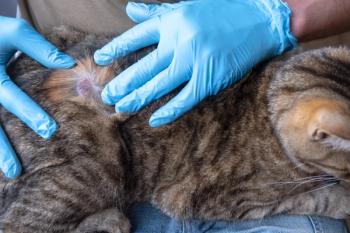
Place your bets: How will the market shift next?
The growing number of players competing in the veterinary marketplace poses new financial-and ethical-challenges for practitioners.
I am continually surprised at the number of veterinarians who tell me they have not read the Bayer Veterinary Care Usage Study released in early 2011. Without rehashing a report you owe it to yourself to read, I'd like to draw your attention to a number of factors at play that affect veterinary client visits and the veterinary marketplace. If you are not aware of these factors, how will you respond? Indeed, how will your practice survive?
More players at the table
One of the key factors cited in the study is fragmentation of the industry. Simply stated, this means that traditional veterinary practices are not the only game in town anymore—pet owners have many choices about where they receive services, products and professional input. Now, a lot of this fragmentation is not new. There have long been not-for-profit programs, such as county and municipal facilities, that offer full care. For-profit mobile vaccination clinics that set up at various retail facilities have existed for years in many areas of the country—there are just more of them now, or at least they're more visible. Online pharmacies and retail outlets that compete with veterinary dispensing have been around for long enough that they're taken for granted as a reality of our business. Most of their impact has been on practices' sales of flea and tick control products and other parasiticides, although some Internet shoppers also purchase ongoing prescriptions such as NSAIDS or endocrine drugs.
Michael Paul, DVM
In most cases, the cost differential is relatively small, but reality and perception are not always the same. Pet owners may, at times, believe that veterinarians overcharge or make recommendations based on their own financial benefit. Again, it doesn't matter what's true—that belief alone may lead pet owners to seek alternative care and product providers.
Another factor: Patents on a number of veterinary drugs will expire shortly, opening the gate for new generic products. Most veterinarians use and prescribe generics every day. Why? Because they believe these products to be of equal efficacy and know them to be less expensive for them and the pet owner. The marketplace also has a number of parasite control products to choose from, which have become largely commoditized. As a result, the Internet has become a prominent supplier of these products. The lack of almost any value differentiation among products or product sources to the consumer has made it almost inevitable that price would be pet owners' primary decision driver.
In the future, pet owners will purchase drugs and other products from one of three sources: the veterinarian, the Internet or retail superstores. Surveys have indicated, using flea and tick products as an example, that about one-third of pet owners are loyal to the veterinary distribution chain. About one-third primarily shop "elsewhere" and about one-third purchase somewhat by convenience: "I'm here. It's here. I'll take it."
Deal in the big box stores
Recently we've had new entrants into the veterinary marketplace. Big stores such as Walmart, Target and some supermarket chains have begun filling pet prescriptions not only with generic products but also with veterinary-labeled drugs. I'm sure the CEOs of these companies, which see billions of dollars in annual revenue, aren't thinking that a few packets of heartworm preventive will affect their bottom line directly. The impact will come with the "while you're here" factor. Generally, when you go to the market for a quart of milk, you come home with a quart of milk, a loaf of bread, a carton of orange juice and, oh yes, a Snickers bar.
While a prescription is being filled at a superpharmacy, the shopper can wander the aisles. First she loads her arms, then she grabs one of those little plastic baskets and, finally, she graduates to a cart so she can carry the case of Diet Coke that's on sale. That's the impact a free or greatly discounted prescription has. When a pet owner comes to a veterinary hospital for a refill, she waits in the reception area reading expired magazines and guarding herself from friendly pets waiting their turn. Not quite as pleasant, productive or profitable.
The "human model" of drug distribution that's being promoted by consumer protection legislation, chain stores and, of course, some members of the pet health industry is based not only on price but on convenience—and what's wrong with that? Isn't that what you want when you're a consumer making buying decisions?
Now look at what client compliance has been with veterinary recommendations. The emerging manufacturers and retail market chains have absolutely huge marketing budgets. How effective are we at marketing our products or services?
So is it all bad? Do these companies represent the evil empire? Is Walmart or Sam's Club really Darth Vader's death star? One of our goals as veterinarians is to provide healthcare for as many animals and pet owners as possible. Clearly, we reach only about half of pets. Their owners simply don't come to us, don't believe what we tell them or don't value what we do. Our name is in front of them only when it is necessary. Now look at the chains we have mentioned. How many Walmart stores are in your area? How prominent are their signs? How can you miss the Target logo everywhere you go? It's not uncommon to see four Walgreens pharmacies in a quarter-mile circle. Kroger. Publix. Winn-Dixie. All are making an entrance into the veterinary pharmacy and dispensing world.
It is unlikely that the existing prescription model will disappear anytime soon. Change comes fast, but adoption of change comes more slowly. The new model that involves commercial pharmacies will not replace the old—it will augment it. They have bigger marketing budgets and a consumer perception we can only envy.
Ethical questions up the ante
All of this raises a bit of an ethical dilemma. As products get less and less expensive and become more readily available through alternative channels, there is a real financial impact on the profitability of veterinary clinic dispensing. Not a good thing. At the same time it makes products more affordable to more people, which hopefully translates to more pets being better cared for. Which takes precedent: pet care or practice profitability? What if some prescriptions were available for less—or even for free? (In a few areas they are, you know.) If you don't believe the word "free" works, read Free: The Future of a Radical Price (Hyperion, 2009). Do we have an obligation to inform our clients of these other options? I'm not sure I know the answer to these questions.
If superstores are effective at raising the awareness of pet health, is that a bad thing? If they tell pet owners to go to their veterinarians for a heartworm test so they can buy the drug from them cheaper, is that a bad thing? At least they're not providing medical care or wellness clinics—yet.
I am a firm believer that consumers will always win eventually. They will always get what they want. So what does the consumer want when it comes to drug and product availability?
In a recent industry survey by Trone, a major marketing research company, consumers were asked their perspectives on these issues. Here are some of the results:
- 70 percent of pet owners said they were committed to their veterinarian, likely to trust veterinary recommendations and likely to consider additional services.
- 56 percent of pet owners said they were still most likely to purchase products and drugs from veterinary sources. (Interestingly, 77 percent of veterinarians expected that pet owners would continue to purchase from them.)
- Only 35 percent of pet owners believe that veterinary-only flea and tick products are superior.
- Only 51 percent believe that products available through veterinarians are best.
Change is never easy and in this case it might be downright painful. The profession must decide how best to address this new entrant into the world that has heretofore been nearly a monopoly.
As Robert Kreigel and Louis Patler said in their book by the same title, "If it ain't broke, break it." Unfortunately, because the old model seemed to be working so well, we didn't address its flaws. A similar old saw says, "If it ain't broke, don't fix it." Well it is broke! And we must fix it.
Relationships: A sure thing
The easiest response to these changes is for veterinarians to compete on price. Coupons, rebates and manufacturer discounts to veterinarians may all bring prices down to a competitive level, but coupons and rebates are inconvenient. And relying on veterinary practices to pass on manufacturer discounts? Well, we'll see.
The only true differentiator between us and growing number of alternative product resources is the veterinarian-client relationship, a tool that's been too long neglected. A great deal of energy is currently being put forth to help veterinarians better convey their commitment and their knowledge. But it might be too little too late. Many veterinarians have sacrificed client and customer relationships, and customer loyalty has eroded. And relationships are much harder to rebuild than they are to build.
As a profession we must focus on who we are, what we know and what we want to do for each pet and pet owner. What we don't want to do is put ourselves in a position where we are perceived as being resistant to more pets having greater access to the medications we recommend in our practices. That is an indefensible position.
Dr. Paul is a veterinary consultant and a founding member and former executive director/CEO of the Companion Animal Parasite Council. He has served as president of the American Animal Hospital Association. He lives in Anguilla in the British West Indies.
Newsletter
From exam room tips to practice management insights, get trusted veterinary news delivered straight to your inbox—subscribe to dvm360.





